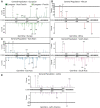Emerging insights into ethnic-specific TP53 germline variants
- PMID: 37352403
- PMCID: PMC10560603
- DOI: 10.1093/jnci/djad106
Emerging insights into ethnic-specific TP53 germline variants
Abstract
The recent expansion of human genomics repositories has facilitated the discovery of novel TP53 variants in populations of different ethnic origins. Interpreting TP53 variants is a major clinical challenge because they are functionally diverse, confer highly variable predisposition to cancer (including elusive low-penetrance alleles), and interact with genetic modifiers that alter tumor susceptibility. Here, we discuss how a cancer risk continuum may relate to germline TP53 mutations on the basis of our current review of genotype-phenotype studies and an integrative analysis combining functional and sequencing datasets. Our study reveals that each ancestry contains a distinct TP53 variant landscape defined by enriched ethnic-specific alleles. In particular, the discovery and characterization of suspected low-penetrance ethnic-specific variants with unique functional consequences, including P47S (African), G334R (Ashkenazi Jewish), and rs78378222 (Icelandic), may provide new insights in terms of managing cancer risk and the efficacy of therapy. Additionally, our analysis highlights infrequent variants linked to milder cancer phenotypes in various published reports that may be underdiagnosed and require further investigation, including D49H in East Asians and R181H in Europeans. Overall, the sequencing and projected functions of TP53 variants arising within ethnic populations and their interplay with modifiers, as well as the emergence of CRISPR screens and AI tools, are now rapidly improving our understanding of the cancer susceptibility spectrum, leading toward more accurate and personalized cancer risk assessments.
© The Author(s) 2023. Published by Oxford University Press.
Conflict of interest statement
There are no missing disclosures or conflicts of interest associated with this work.
Figures



Similar articles
-
Prevalence of low-penetrant germline TP53 D49H mutation in Japanese cancer patients.Biomed Res. 2016;37(4):259-64. doi: 10.2220/biomedres.37.259. Biomed Res. 2016. PMID: 27545002
-
Analysis of the Li-Fraumeni Spectrum Based on an International Germline TP53 Variant Data Set: An International Agency for Research on Cancer TP53 Database Analysis.JAMA Oncol. 2021 Dec 1;7(12):1800-1805. doi: 10.1001/jamaoncol.2021.4398. JAMA Oncol. 2021. PMID: 34709361 Free PMC article.
-
Blood functional assay for rapid clinical interpretation of germline TP53 variants.J Med Genet. 2021 Dec;58(12):796-805. doi: 10.1136/jmedgenet-2020-107059. Epub 2020 Oct 13. J Med Genet. 2021. PMID: 33051313 Free PMC article.
-
Benign SNPs in the Coding Region of TP53: Finding the Needles in a Haystack of Pathogenic Variants.Cancer Res. 2022 Oct 4;82(19):3420-3431. doi: 10.1158/0008-5472.CAN-22-0172. Cancer Res. 2022. PMID: 35802772 Review.
-
Tumor protein 53 mutations and inherited cancer: beyond Li-Fraumeni syndrome.Curr Opin Oncol. 2010 Jan;22(1):64-9. doi: 10.1097/CCO.0b013e328333bf00. Curr Opin Oncol. 2010. PMID: 19952748 Review.
Cited by
-
Therapy-relevant MDM2 amplification in cholangiocarcinomas in Caucasian patients.Ther Adv Med Oncol. 2024 Nov 9;16:17588359241288123. doi: 10.1177/17588359241288123. eCollection 2024. Ther Adv Med Oncol. 2024. PMID: 39525665 Free PMC article.
-
Understanding the complexity of p53 in a new era of tumor suppression.Cancer Cell. 2024 Jun 10;42(6):946-967. doi: 10.1016/j.ccell.2024.04.009. Epub 2024 May 9. Cancer Cell. 2024. PMID: 38729160 Free PMC article. Review.
-
Genomic landscape of childhood acute lymphoblastic leukemia in Malaysia: insights from array-CGH.Mol Cytogenet. 2025 Mar 28;18(1):7. doi: 10.1186/s13039-025-00709-4. Mol Cytogenet. 2025. PMID: 40155977 Free PMC article.
-
Current insights and future directions of Li-Fraumeni syndrome.Discov Oncol. 2024 Oct 15;15(1):561. doi: 10.1007/s12672-024-01435-w. Discov Oncol. 2024. PMID: 39404911 Free PMC article. Review.
References
-
- Leroy B, Anderson M, Soussi T.. TP53 mutations in human cancer: database reassessment and prospects for the next decade. Hum Mutat. 2014;35(6):672-688. - PubMed
-
- Malkin D, Li FP, Strong LC, et al.Germ line p53 mutations in a familial syndrome of breast cancer, sarcomas, and other neoplasms. Science. 1990;250(4985):1233-1238. - PubMed
-
- McCuaig JM, Armel SR, Novokmet A, et al.Routine TP53 testing for breast cancer under age 30: ready for prime time? Fam Cancer. 2012;11(4):607-613. - PubMed
-
- Sheng S, Xu Y, Guo Y, et al.Prevalence and clinical impact of TP53 germline mutations in Chinese women with breast cancer. Int J Cancer. 2020;146(2):487-495. - PubMed
Publication types
MeSH terms
Substances
Grants and funding
LinkOut - more resources
Full Text Sources
Medical
Research Materials
Miscellaneous

